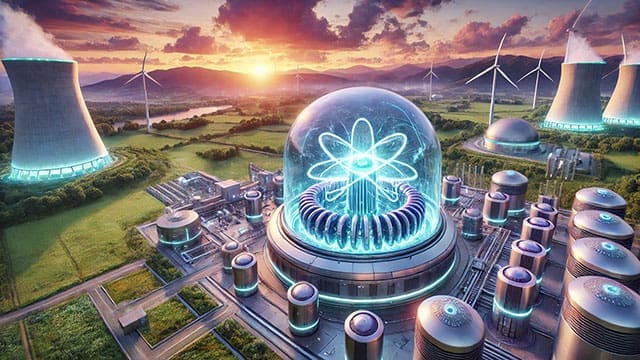Fusion energy holds the potential to revolutionize the global energy landscape, offering a cleaner, safer, and nearly limitless power source

For interview requests, click here
In recent years, much has been made of the promises that nuclear fusion could hold for the future of energy. However, despite fusion’s potential to revolutionize global energy systems, discussions about its broader social, economic, and geopolitical implications are surprisingly limited.
I recently had a conversation with Dr. Allan Offenberger, a leading expert in fusion energy from the University of Alberta, which opened my eyes to just how significant this technology could be, not only for energy production but for the entire global order.
For those unfamiliar, nuclear fusion is the process of combining atomic nuclei to release energy – the same process that powers the sun. Unlike nuclear fission, which splits atoms and has long been a controversial energy source due to the dangerous radioactive waste it produces, fusion promises to be cleaner, safer, and virtually limitless. The implications are enormous.
Dr. Offenberger made it clear from the outset: achieving controlled nuclear fusion on Earth is one of the greatest scientific challenges humanity has ever faced. It has been described as the toughest technological nut to crack. Over the past few decades, the global scientific community has dedicated considerable time and resources to understanding the complexities of fusion, from the necessary temperatures to the magnetic confinement needed to contain the reaction.
 |
| Recommended |
| The emergence of fusion energy
|
| Nuclear fusion could solve our energy and environmental problems
|
| Global energy transition is doomed without a realistic plan
|
The recent “breakthrough” announced at Lawrence Livermore National Laboratory – while exciting – represents just the tip of the iceberg. As Dr. Offenberger noted, the achievement was more of a scientific milestone than a true solution for energy production. It is important to recognize that while we have come a long way, the road ahead is still filled with challenges.
However, the scientific triumph of reaching the conditions necessary for fusion to occur is significant. We now know that fusion is possible, and in the coming years, we are likely to see even more promising results from other fusion methods, such as magnetic confinement.
According to Dr. Offenberger, one of the most remarkable aspects of fusion energy is its potential to provide clean and abundant energy without the drawbacks of current energy sources. Unlike fossil fuels, which release harmful greenhouse gases, or even traditional nuclear power plants, which produce hazardous radioactive waste, fusion offers a much cleaner alternative. Fusion energy has no long-term radioactive waste issues and does not emit greenhouse gases, making it an incredibly attractive option for those concerned about climate change.
This environmental benefit alone could make fusion a game-changer in the fight against global warming. As Dr. Offenberger said, “If we want energy, we’re going to have to accept living with some undesirable aspects, but fusion has significantly fewer than any other energy source.” Compared to the life cycle analysis of other energy sources, fusion is the cleanest by far. If commercialized, it could provide the world with an abundant supply of energy, helping to mitigate some of the most pressing environmental challenges we face today.
Perhaps even more fascinating are the potential geopolitical implications of fusion energy. Today, many of the world’s geopolitical conflicts are rooted in the control and distribution of energy resources, particularly oil and gas. A significant number of countries, including Canada, are major players in the global energy economy, and their influence is tied directly to their ability to supply the world with fossil fuels.
However, as Dr. Offenberger pointed out, fusion could upend this balance. Fusion relies on deuterium, which can be extracted from seawater, and tritium, which can be produced from lithium. Unlike oil and gas, these resources are widely available, meaning that fusion energy would not be controlled by a few powerful nations. Instead, it could lead to energy independence for many countries, reducing the geopolitical tensions that arise from energy scarcity.
The shift to fusion energy could have profound effects on countries that rely heavily on oil and gas exports. As fusion becomes commercially viable, the demand for fossil fuels would decline, potentially destabilizing economies that depend on oil revenue. Countries like Saudi Arabia and Venezuela would need to diversify their economies to avoid economic collapse, and even energy-rich regions like Alberta would need to adapt to this new reality.
Fusion’s potential for disruption doesn’t stop at the geopolitical level. As Dr. Offenberger explained, the transition to fusion will be slow, likely taking a generation or more to roll out fully. During this time, industries built around current energy sources will face challenges. Fossil fuel industries will likely resist the change, attempting to defend their capital investments for as long as possible. This pattern is typical of technological transitions – just as steam engines were replaced by more efficient engines, so too will today’s energy infrastructure evolve.
While this change may be painful for some industries, Dr. Offenberger remains optimistic. The younger generation, he believes, will embrace fusion more readily than the “old guard” and will be instrumental in driving this energy revolution forward. Over time, fusion’s benefits – clean, abundant energy with minimal environmental impact – will outweigh the initial disruptions caused by its introduction.
As I reflect on what I learned from Dr. Offenberger, one thing is clear: fusion energy has the potential to reshape the world. From reducing our dependence on fossil fuels to minimizing environmental degradation, fusion offers a brighter, cleaner future. However, realizing this potential will require continued investment in research and development, as well as careful planning to manage the economic and social disruptions that are sure to come.
While fusion is not yet ready to power our homes and industries, the progress made thus far is encouraging. Indeed, it is worth noting that the recent breakthrough at Livermore has stimulated investment of billions of dollars by companies worldwide and billions more by the governments of the US, UK, Germany, Japan and China.
With the right mindset and continued innovation, fusion could well be the key to solving many of the world’s most pressing challenges.
Dr. Perry Kinkaide is a visionary leader and change agent. Since retiring in 2001, he has served as an advisor and director for various organizations and founded the Alberta Council of Technologies Society in 2005. Previously, he held leadership roles at KPMG Consulting and the Alberta Government. He holds a BA from Colgate University and an MSc and PhD in Brain Research from the University of Alberta.
Explore more on Energy security, Energy transition, Science
The opinions expressed by our columnists and contributors are theirs alone and do not inherently or expressly reflect the views of our publication.
Troy Media
Troy Media is an editorial content provider to media outlets and its own hosted community news outlets across Canada.
